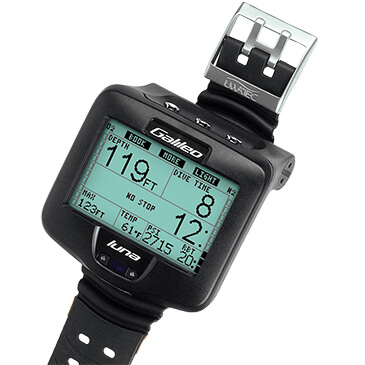Lesson 112
More about dive computers and tables
By the end of this section, I should be able to answer these questions:
1. How does a dive computer or dive table estimate the amount of nitrogen I absorb during a dive?
2. Does a dive computer or dive table directly assess anything going on inside a diver’s body?
3. Why can no dive computer or table guarantee that decompression sickness will never occur, even within its limits? How do I address this concern?
How Dive Computers and Tables Work
Dive computers and dive tables work by using your dive time and depth information to calculate the theoretical amount of nitrogen in your body. They compare these estimates against limits that resulted from experimental dives and human experience.

Dive computers measure depth and time throughout a dive (and after) and apply the information to the decompression model electronically. A computer constantly updates the theoretical nitrogen in your body based on your dive depths and time, and compares it to the model. Dive computers have become the most common method of calculating decompression information.
Before dive computers, divers only used dive tables. With the Recreational Dive Planner (RDP) Table, you use the depth from a depth gauge and the time from a timer or watch to look up limit information on the RDP Table version. The eRDPML on the other hand, is a calculator-format electronic dive table. You enter your depth/time information, and it looks it up on the table for you.
No Direct Assessment
Dive computers and dive tables do not directly read anything going on inside a diver’s body. They apply a mathematical decompression model that works for the vast majority of people most of the time. Decompression models are highly reliable, but they cannot account for individual variations in physiology, such as the secondary factors you learned in the last subsection.
Because people vary in their susceptibility to decompression sickness, no dive computer or dive table can guarantee that decompression sickness will never occur, even when you dive within its limits. You must accept that there is always some risk of DCS when you go diving.
Although dive computers and tables cannot account for individual variation, as a diver you can help further reduce risk by always following conservative dive practices.

*Always dive well within the limits of your dive computer or table. The more predisposing factors you have, the more conservative you want to be.
Ascend slowly from every dive (18 metres/60 feet per minute, or slower as required by your computer) and make a three minute safety stop at 5 metres/15 feet.
knowledge review and quiz
Comments

I'll take you diving!
Copyright © Larry Wedgewood Scuba Instruction All Rights Reserved








